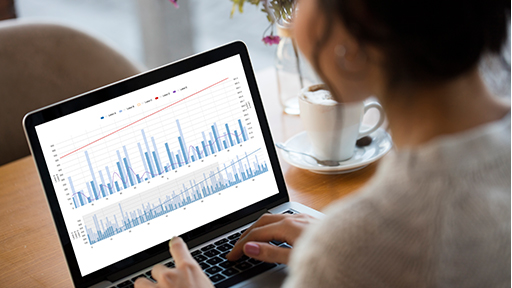Article
Credit Cards Reemerge From Pandemic as Multifaceted Financial Management Tools
Whether it’s for convenience, rewards or the benefits of better data security when making a transaction, consumers with revolving credit are using it not just to fund their spending splurges, but to manage their finances and boost long-term financial freedom.
At a time when roughly six in 10 working Americans overall are living paycheck to paycheck, traditional credit is still among the most powerful tools available — as long as it is available and being used smartly.
Among various users of revolving credit, we see related — but fundamentally different — behaviors.
With 52% of active credit card users living paycheck to paycheck and “sometimes,” “always” or “usually” revolving their balances, compared to only 20% of active card users not living paycheck to paycheck, credit cards are clearly a budgeting tool for many.
Acknowledging the trends, Elan Financial Services Senior Vice President, Market Director Matthew Carpenter told PYMNTS, “As a card issuer, we want to make sure to give card members the resources to make those kinds of decisions and control their financial outcomes through education, resources, budgeting tools, along with giving card members some control in their payments.”
Features valued by cardholders are now centering on flexibility in setting payment date, sending payment and available balance reminders and a more engaging experience.
“Through the smart use of credit, people can build up a stronger and a better credit profile and graduate over time into bigger and better things,” he said.
In the study, The Convenience Catalyst: How Customer Experience Features Drive Credit Card Usage, a collaboration between PYMNTS and Elan (a division of U.S. Bank), we discovered that 38% of active users have paid their balances in full every month.
Carpenter said that it’s important to remind customers to use all the tools at their disposal to keep themselves in good financial position, using budgeting or opportunities to extend payments on larger purchases through their card at a lower rate or at a fixed payment.
Card Behavior Serves as Barometer of Additional Needs
Credit card usage is evolving in new directions as digital payments and the connected economy serve more digital-first consumers.
Giving an idea of the diverse drivers, The Convenience Catalyst found that 27% of active credit card users cite convenience as their top reason for using credit cards, while 25% of consumers “primarily pay via credit cards to access usage-based rewards.”
“For younger generations, it’s pretty common to see them charging everything down to a cup of coffee,” Carpenter said, while 30 to 40 years ago, people only pulled their credit card out when it was an emergency or a large purchase.
Carpenter says as more and more people use a card or mobile device in lieu of cash as their primary transactional tool, financial institutions may consider tips and tools like budgeting, financial education support or whatever is needed to help them transact wisely in an increasingly cashless marketplace.
Carpenter told PYMNTS this goes further into questions of how a cardholder is using revolving credit — as a funding mechanism or a borrowing device — which may indicate how the financial institution can be an even greater resource to their customers.
Noting again the 38% who pay balances in full each month, he said, “If you’re a financial institution partner, having someone engaged in your credit card who is using it as a spending tool versus a loan tool tells you a lot about what that customer or member may be looking for, and … could help you offer them other financial products that could be useful in their lives.
“Based on the population someone falls into, you just have to be ready with a strategy and a life cycle plan for that person to keep them engaged.”
Rewards is a perfect example of an area where analyzing cardholder behavior can inform a new generation of rewards that resonate more with young consumers whose spend is growing.
“A couple years ago, we would’ve told you cash rewards are the top of the hill. It’s what the vast majority of people [were] looking for,” he said. “During the last couple years, we’ve learned that new rewards categories started to carry more meaning, like digital streaming services.”
Elan changed its own program in just such a way, recategorizing electric vehicle charging as gas/fuel, with “gas being an accelerated earn product at 2x [or] 3x earn on a reward product.”
“To keep an engaging rewards program, you have to keep shifting the categories of rewards,” Carpenter added. “There’s a lot more rewards today which I would say are targeted to the day-to-day card user. Historically, rewards used to target aspirational things like save up tens of thousands of points for a big trip or something like that. I think we are kind of moving away to more of that focus on daily earn and a more regular redemption pattern.”
Self-Serve and Security Sizzle
As for where this is headed in the new year and next few years, Carpenter foresees an ongoing expansion of the trends forged primarily during the pandemic, but with longer legs.
“We’re going to continue to see a lot more of a digital environment to help control usage [and] control self-servicing,” he said. “We’re seeing more and more integration points with payments products than ever before, things like in-app chat [and] mobile screen sharing to help people solve problems.
“That trend’s going to continue. A lot of people really like that idea of self-servicing. That will continue to grow.”
With nearly 80% of respondents to The Convenience Catalyst study preferring credit cards to other payment forms for their higher levels of security, fraud is another topic to keep top of mind.
“We clearly see how important [fraud prevention] is to cardholders,” Carpenter said. “We’re making a lot of investments in that space.”
He added, “We really try to stay on top of that and make our cardholders feel confident in what we deliver through things like multifactor identification, stronger fraud controls, user controls, transparency back into what’s going on. We really focus on trying, when fraud does happen, to detect it, prevent it and if needed, resolve it.
“We’re definitely doing a very good job there, but it requires continued vigilance because the other side is not losing focus,” meaning fraudsters.
To learn more, download The Convenience Catalyst: How Customer Experience Features Drive Credit Card Usage report.
This article originally appeared on PYMNTS.com on March 2, 2022.
Start a conversation
If you are interested in learning how Elan can help your credit union grow, we'd love to hear from you.


